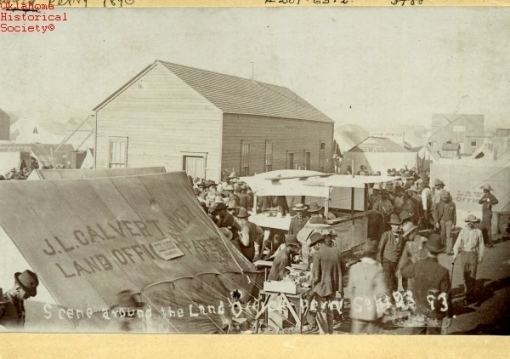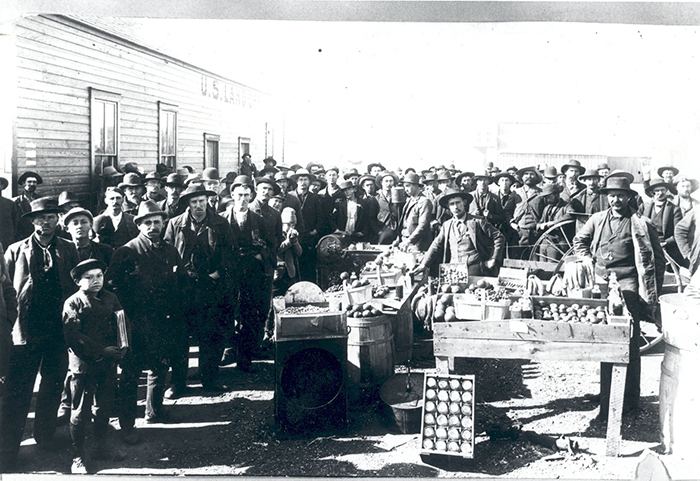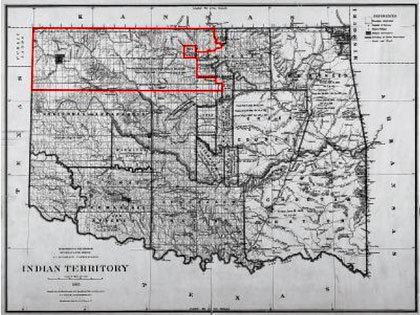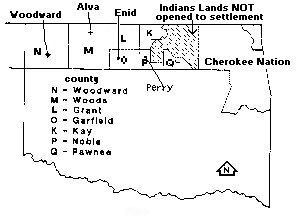Cherokee almanac the cherokee outlet and land rush of 1893
The Cherokee Outlet, often mistakenly referred to as the Cherokee Strip, was located in what is now the state of Oklahoma, in the United States. It was a sixty-mile (97 km) wide strip of land south of the Oklahoma-Kansas border between the 96th and 100th meridians. It was about 225 miles (362 km) long and in 1891 contained 8,144,682.91 acres (32,960 km²). Enid and Woodward fall within the historical boundaries of the Cherokee Outlet.
Contents
- Cherokee almanac the cherokee outlet and land rush of 1893
- Cherokee outlet land run
- Formation
- Loss of Cherokee control
- Cherokee Strip land run
- In popular fiction
- References

The Cherokee Strip was a two-mile strip running along the northern border of much of the Cherokee Outlet, and it was the result of a surveying error. This section of land was known as the Cherokee Strip but the term has often been applied to the whole of the Cherokee Outlet.

Cherokee outlet land run
Formation
The Treaty of New Echota assigned the Cherokee Outlet, along with other lands, to the Cherokee Nation. Ratified on May 23, 1836, it was to be a perpetual outlet to use for passage to travel and hunt in the West from their reservation in the eastern part of what became Oklahoma. This was in addition to the land given to the Cherokees for settlement after their arrival from their home in Georgia.
Loss of Cherokee control

After the Civil War, the United States required a new peace treaty (see Reconstruction Treaties) with the people of the Cherokee Nation due to their alliance with the Confederacy. The new treaty (ratified on July 19, 1866) allowed the United States government to dispose of the land in the Cherokee Outlet: "The United States may settle friendly Indians in any part of the Cherokee country west of 96°... [sale proceeds] to be paid for to the Cherokee Nation..."

The settlement of several tribes in the eastern part of the Cherokee Outlet (including the Kaw, Osage, Pawnee, Ponca, and Tonkawa tribes) separated it from the Cherokee Nation proper and left them unable to use it for grazing or hunting. After the Civil War, Texans began driving their cattle across the Outlet to markets in Kansas. Soon other European-American ranchers began using the land for grazing. In the early 1880s, with the support of the Cherokee, the ranchers using the land got organized and began fencing off individual claims. The Cherokee believed such organization would help them collect rents due them for land use. Also during the 1880s, Bill McDonald, acting as deputy U.S. Marshal for the Southern District of Kansas and the Northern District of Texas, cleared the Cherokee Strip of cattle thieves and train robbers, who had taken to hiding out in what they thought was a kind of "no-man's land".

In March 1883, Kansas cattlemen incorporated under the laws of Kansas to form the The Cherokee Strip Live Stock Association. They negotiated a five-year lease for the entire outlet for $100,000 per year, payable semi-annually in advance. At the end of the five years, the Cherokee Nation Tribal Council put the lease up for bid, hoping to get a better price. The Cherokee Strip Live Stock Association eventually got the bid for $200,000 per year, but the lease was nullified by Congress, which then authorized purchasing the land for $1.25 per acre. Having previously rejected a bid from the cattlemen to buy the land for $3.00 per acre, the Cherokee protested in vain that the government price was too low. President Benjamin Harrison forbade all grazing in the Cherokee Outlet after October 2, 1890, which eliminated all profit from leasing the land. After that, the Cherokee sold off the land at prices ranging from $1.40 to $2.50 per acre. The Cherokee Strip Live Stock Association would disband in 1893, the same year the Outlet was opened to non-Indian settlement.
Actual payment did not occur until 1964, when the Cherokee finally settled their claims against the U.S. government for the actual value of the Cherokee Strip land opened to settlement in 1893. This amounted to about $14.7 million, which was paid to the original allotment holders or their heirs. The tribe also received an additional $2 million in accrued interest.
The Organic Act of 1890 incorporated the Unassigned Lands into the new Oklahoma Territory. In 1907 Oklahoma became the 46th state.
Cherokee Strip land run
In 1889, Congress authorized the Cherokee Commission to persuade the Cherokee to cede their complete title to the Cherokee Outlet. After a great amount of pressure, and confirmed by a treaty Congress approved March 17, 1893, the Cherokee agreed, for "the sum of $8,595,736.12, over and above all other sums" to turn title over to the United States government. On September 16, 1893, the eastern end of the Cherokee Outlet was settled in the Cherokee Strip land run, the largest land run in the United States and possibly the largest event of its kind in the history of the world.
In popular fiction
The Cherokee Outlet and the actions of the cattlemen play a prominent role in a portion of the Matt Braun western novel The Kincades. The names of the characters have been changed, but the basic actions taken are explored.
